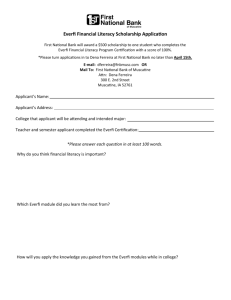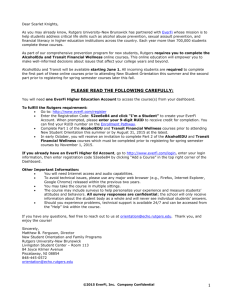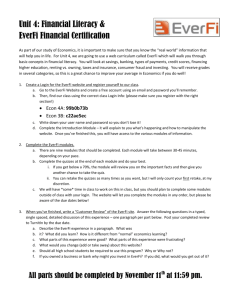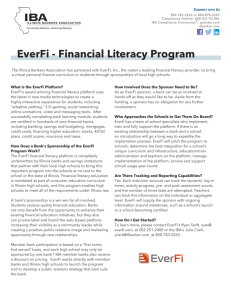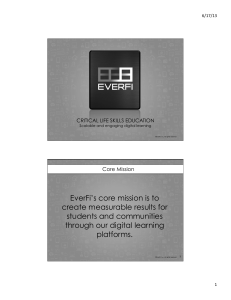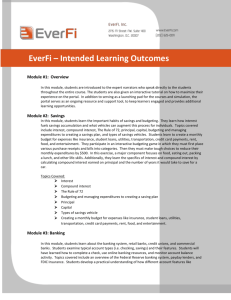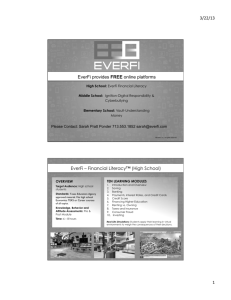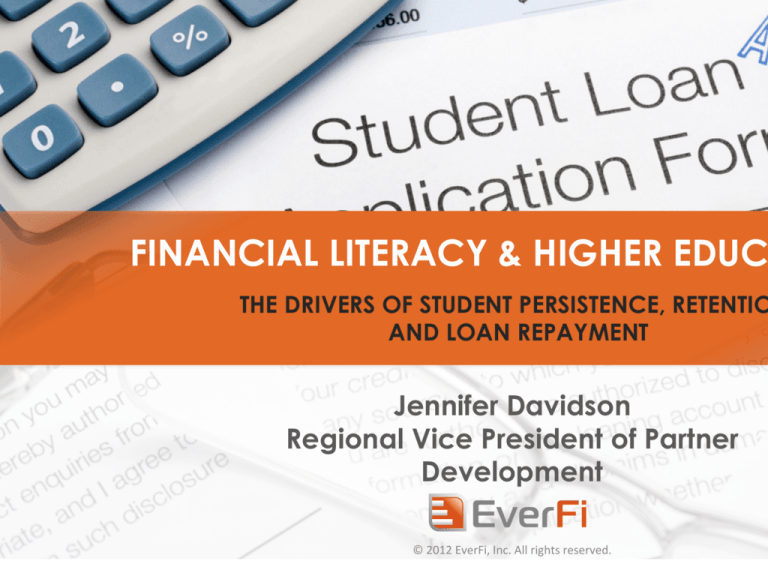
FINANCIAL LITERACY & HIGHER EDUC
THE DRIVERS OF STUDENT PERSISTENCE, RETENTIO
AND LOAN REPAYMENT
Jennifer Davidson
Regional Vice President of Partner
Development
© 2012 EverFi, Inc. All rights reserved. OVERVIEW
1
Review of the previous research
2
Demographic variation of debt-related
attitudes and behaviors
3
Can attitudes towards debt and spending
impact behavior?
4
Implications for practice
© 2012 EverFi, Inc. All rights reserved. DRAMATIC INCREASE IN STUDENT DEBT
© 2012 EverFi, Inc. All rights reserved. THE IMPACT OF FINANCIAL CONCERNS ON
COLLEGE STUDENT PERSISTENCE
“The number one reason for students
leaving college is debt and financial
stress, followed by poor academic
performance and poor social fit”
— Hoffman, Mckenzie, & Paris, 2008; Chiang, 2007
© 2012 EverFi, Inc. All rights reserved. FINANCIAL LITERACY ON THE NATIONAL AGENDA
© 2012 EverFi, Inc. All rights reserved. LINKAGE BETWEEN FINANCIAL
LITERACY AND BEHAVIOR
1
Retirement planning
2
Participating in the stock market
3
Choosing mutual funds with lower fees
4
Paying lower fees and interest charges on credit cards
© 2012 EverFi, Inc. All rights reserved. DO WE HAVE A COMPLETE DEFINITION?
“75 percent of financial literacy studies used the terms
‘financial literacy’ and ‘financial knowledge’ interchangeably”
“89 percent of the studies did not provide a threshold for the
measurement of financial literacy”
Financial literacy should include more than measurement of
knowledge, but also account for consumers’ attitudes,
behaviors and planned actions.
Sandra Huston, Associate Professor within the Personal Financial Planning Division at Texas Tech University
© 2012 EverFi, Inc. All rights reserved. CURRENT INVESTIGATION
SAMPLE SIZE
AGE
GENDER
RACE/ETHNICITY
MEASUREMENT
72.6 % Caucasian/
White
Attitudes of debt &
saving
10.3 % Asian/Pacific
Islander
30,165
Incoming
College
Students
Mean
age: 18.5
Years old
55%
Female
Buying behaviors
8.4% Latino/ Hispanic
7.5% Black/ African
American
.5% Native
American/ Alaskan
© 2012 EverFi, Inc. All rights reserved. Planning behaviors
Current debt situation
EXAMINING RACIAL DISPARITIES IN
FINANCIAL RISK
Correlating Financial Risk and
Race/Ethnicity
Higher Default Rates Among
Students of Color.
§ Hispanic and Black/AA youth were at
higher risk of credit card default, and to
have more debt
§ Most likely to not pay their credit cards
in full and to max out their credit card
limit
§ Most tolerant of high-risk debt
practices overall
§ Most likely to report utilizing credit card
cash advances and payday lending
practices
© 2012 EverFi, Inc. All rights reserved. CURRENT/FUTURE DEBT: CREDIT CARDS
62%
of incoming freshmen reported
having a credit card
40%
of those students received their first
credit card under the age of 17 9%
of credit card holders reported having been
late paying their credit cards at least once 23%
of students reported credit card debt
between $1,000 – $10,000 © 2012 EverFi, Inc. All rights reserved. CURRENT/FUTURE DEBT: SCHOOL LOANS
73%
of students report that they already have or plan to
take out college loans before they leave college
Only
~24%
but
68%
report “likely to consolidate” and other issues
(e.g. knowing interest rate, only taking out what
they need) estimate their final school loan total will
be between $10,000 and $40,000 © 2012 EverFi, Inc. All rights reserved. THE STATE OF COLLEGE STUDENT
FINANCIAL BEHAVIOR
28%
of students reported that they plan to buy
something even though they can’t afford it
32%
of students report frequently making only the
minimum payments on their credit card
11%
of students reported at least a moderate likelihood
of going to a payday lender
13%
of students reported writing a check even though
they knew they didn’t have enough money in
their bank account to cover it
19%
of students reported at least a moderate
likelihood of using a credit card for a cash loan
© 2012 EverFi, Inc. All rights reserved. FINANCIAL ATTITUDES & BEHAVIORS ACROSS
THE STATES
© 2012 EverFi, Inc. All rights reserved. FINANCIAL ATTITUDES & BEHAVIORS ACROSS
THE STATES
© 2012 EverFi, Inc. All rights reserved. FINANCIAL ATTITUDES & BEHAVIORS ACROSS
THE STATES
© 2012 EverFi, Inc. All rights reserved. ATTITUDE TOWARDS DEBT
AVOIDANCE 44% 56% TOLERANCE CLUSTERS BASED ON STUDENT ATTITUDES TOWARDS:
•
•
“Banks should not give interest free overdrafts”
“Students have to go into debt”
•
•
“It’s okay to have an overdraft if you know you can pay it off”
“It’s better to have something now and pay for it later”
© 2012 EverFi, Inc. All rights reserved. ATTITUDE TOWARDS DEBT
AVOIDANCE 44% 56% TOLERANCE “TOLERANCE” CLUSTER MEMBERSHIP PREDICTED A(N):
INCREASED:
DECREASED:
• likelihood to have high credit card
debt (5,000 +)
• likelihood to budget
• likelihood to report difficulty paying
loans & credit cards on time/in full
• likelihood to check their credit score
• likelihood to participate in risky
debt behavior
• likelihood to save money
© 2012 EverFi, Inc. All rights reserved. FUTURE DIRECTIONS IN FINANCIAL LITERACY
EDUCATION
1
We need a developmental perspec?ve 2
Late ?ming, knowledge-­‐based educa?on might not be enough. 3
Early-­‐onset, with periodically-­‐based booster. 4
Popula?on-­‐level educa?on © 2012 EverFi, Inc. All rights reserved. Todd Wyatt – Director of Research
TODD@EVERFI.COM
© 2012 EverFi, Inc. All rights reserved.

